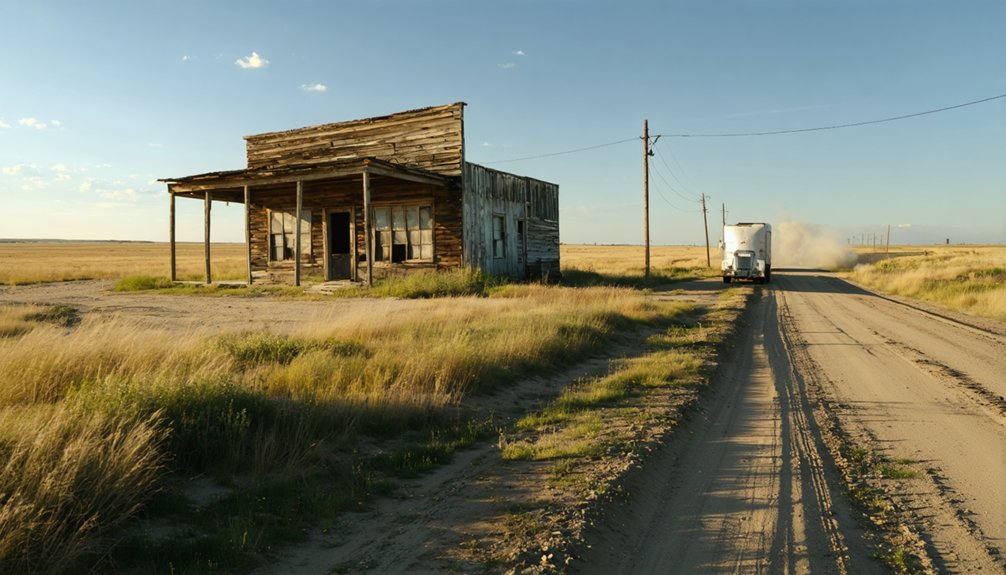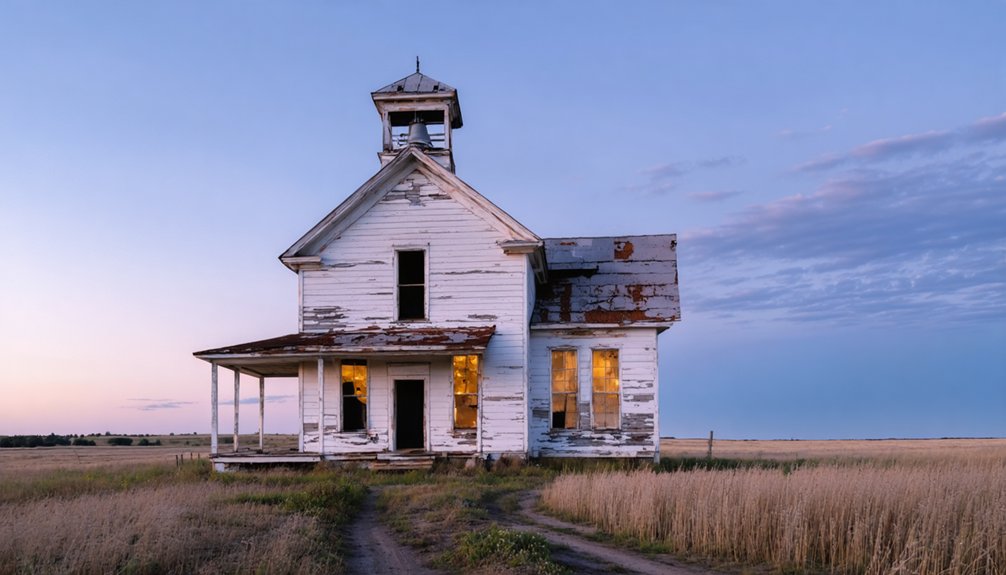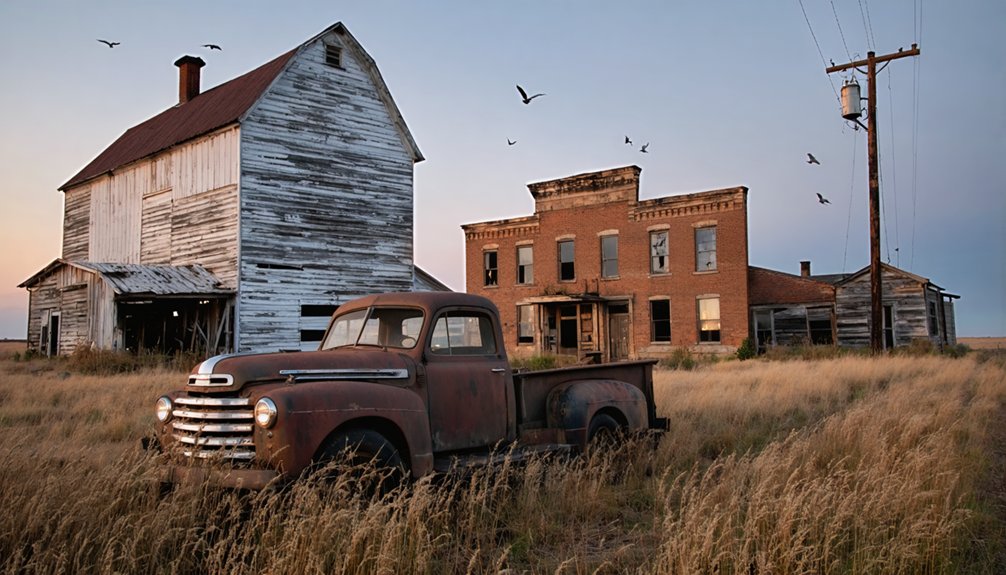You’ll find Creston, SD about 30 miles east of Rapid City, where a concrete dinosaur still stands guard over this former Milwaukee Railroad stop. Founded in the 1880s, the town thrived until Interstate 90‘s construction and the railroad’s closure in 1980 sealed its fate. The 1933 dinosaur sculpture, North America’s first roadside attraction of its kind, survived thanks to local restoration efforts – a proof of the region’s pioneering spirit and hidden stories.
Key Takeaways
- Creston transformed from a thriving Milwaukee Railroad stop in the 1880s to a ghost town following economic isolation and railroad closure.
- The construction of Interstate 90 in the 1960s redirected traffic away from Creston, causing local businesses to close.
- The town’s 1933 concrete dinosaur attraction, North America’s first roadside dinosaur sculpture, remains a testament to its former vitality.
- Located 30.5 miles east of Rapid City, Creston lost its commercial importance after the Milwaukee Railroad ceased operations in 1980.
- Abandoned railway bridges and deteriorating infrastructure mark Creston’s decline from a bustling transport hub to a deserted settlement.
The Rise and Fall of a Railroad Town
While many South Dakota towns emerged along railroad lines in the late 1800s, Creston’s story began specifically as a Milwaukee Railroad stop that would briefly flourish before fading into history.
You’ll find its origins in the early 1880s, when railroad expansion brought settlers and established a crucial post office in this southwestern corner of the territory. The Milwaukee Road’s presence sparked modest but steady growth, with the town developing essential services like general stores and rail facilities. The town followed the characteristic T-shape layout common to railroad settlements of the era.
Like towns such as Dakota City, Creston relied heavily on local speculators who invested in land along anticipated railroad routes.
During Creston’s peak, you’d have witnessed a resilient community where life revolved around train schedules and agricultural shipments.
But the post-WWII shift to automobiles and trucks proved devastating. As railway lines were abandoned and Interstate 90 bypassed the town, Creston’s role as a transportation hub gradually disappeared.
A Dinosaur’s Tale: North America’s First Roadside Attraction
Before roadside attractions dotted America’s highways, a pioneering concrete dinosaur emerged in 1933 on Creston’s prairie landscape.
You’ll find this remarkable creation, built by sculptor Emmet A. Sullivan, standing as North America’s first dinosaur attraction, constructed from scrap metal, wood framework, and wire mesh covered in concrete.
While serving as a beacon for weary travelers, this prehistoric sentinel marked the spot of a local general store, revolutionizing roadside marketing in South Dakota.
Ingeniously positioned, this concrete dinosaur transformed a simple store into South Dakota’s first must-see roadside destination.
Sullivan’s innovative design would later influence other attractions, including Rapid City’s Dinosaur Park, which was dedicated in 1936.
Today, you can still spot this weathered giant from Highway 44, where it continues to capture imaginations as the original roadside colossus that sparked America’s love affair with oversized roadside landmarks.
The once-vibrant green attraction now shows its age with visible structural braces supporting its neck and abdomen.
Location and Geographic Significance
Nestled in Pennington County’s prairie landscape, Creston’s ghost town lies approximately 30.5 miles east of Rapid City along State Highway 44.
You’ll find this former railway village at coordinates 43°54’35″N and 102°41’55″W, surrounded by the rolling terrain of western South Dakota’s Great Plains. The site’s strategic position along the Chicago, Milwaukee, St. Paul and Pacific Railroad made it a crucial transport hub until 1980. Today, a big concrete dinosaur stands as a distinctive roadside attraction for passing travelers. The structure, which was built in 1933, draws curious onlookers to this otherwise desolate location.
- Several abandoned railway bridges within 4 km testify to Creston’s former rail infrastructure
- The confluence of Spring Creek and Cheyenne River sits just 4.9 km from the site
- Wall (36 km) and New Underwood (21 km) are the nearest populated communities
- The location’s open prairie setting features sparse vegetation and native wildlife
Life in Creston’s Heyday
During Creston’s peak years, you’d find railroad workers starting their days before dawn, maintaining tracks and coordinating the multiple rail lines that converged on the small town.
The bustling Main Street featured essential services centered around the post office established in 1887, where workers and their families collected mail and exchanged news. Just as at ghost towns nearby, visiting these abandoned places today offers a fascinating glimpse into early South Dakota life. Like many communities in the region, the town’s prosperity relied heavily on placer mining operations.
You’d spot railroad employees gathering at boarding houses between shifts, while mill workers from the town’s primary sawmill operation maintained a steady flow of timber processing throughout the workday.
Railroad Workers’ Daily Routines
Railroad workers in Creston followed a rigorous daily schedule that began well before dawn, when the whistle’s echo would pierce the South Dakota morning darkness.
You’d find workers huddled near the steam engines, checking water levels and stoking coal fires. These railroad routines shaped the rhythm of life in Creston, with 12-hour shifts becoming the norm.
Worker camaraderie flourished in the communal boarding houses, where you’d share hearty meals and stories after long days on the rails.
- Engineers and firemen worked in tandem to maintain precise steam pressure throughout their runs.
- Brakemen coordinated with conductors across the network via telegraph signals.
- Maintenance crews inspected every inch of track to prevent dangerous failures.
- Section hands performed backbreaking manual labor to keep the infrastructure sound.
Main Street Business Scene
Three bustling blocks made up Creston’s Main Street during its 1920s peak, where you’d find a mix of essential businesses serving the town’s mining and railroad workforce.
The commercial diversity included a well-established bank, general stores stocking mining supplies, and boarding houses where single miners found lodging. Like the town of Awanka, Creston once featured two busy hotels that served travelers and temporary workers. You could handle your mail at the post office, which moved locations as the town evolved.
Many buildings served multiple purposes, reflecting the practical nature of frontier commerce. The general mercantile might double as your community gathering spot, while some businesses adapted to changing needs.
When you visited Main Street, you’d find everything from basic provisions to mining equipment, all supported by the crucial railroad connection that kept Creston’s economy moving until its eventual decline.
The Impact of Interstate 90

When Interstate 90’s construction bypassed Creston in the mid-20th century, you’d have witnessed the town’s immediate economic isolation as traffic patterns permanently shifted away from local routes.
You’d have seen local businesses struggle as the steady stream of travelers disappeared, forcing many shopkeepers to close their doors and relocate to better-connected communities.
If you’d visited during the 1980s, you’d have found a town stripped of its commercial importance, with the closure of the Milwaukee Railroad dealing a final blow to Creston’s chances of survival. Much like Ardmore and Okaton, Creston’s population dwindled rapidly as agricultural changes and harsh economic conditions forced residents to seek opportunities elsewhere.
Economic Isolation Begins
The construction of Interstate 90 in the mid-20th century marked the beginning of Creston’s steady decline into isolation.
You’ll find that as traffic bypassed the town, local businesses faced mounting economic challenges. The once-bustling community watched as shops closed their doors and essential services disappeared, testing the limits of community resilience.
- Local commerce dwindled rapidly as travelers chose the interstate over traditional routes
- Essential services, including restaurants and shops, couldn’t sustain operations
- Job opportunities vanished, forcing residents to seek employment elsewhere
- Infrastructure maintenance declined, making daily life increasingly difficult
The impact rippled through every aspect of town life.
Without steady customer flow, businesses couldn’t maintain profitability, and the workforce began to shrink. Your once-thriving local economy transformed into a struggle for survival as isolation took hold.
Traffic Patterns Shift Forever
As Interstate 90 carved its path through southern South Dakota in the 1960s, Creston’s fate took a decisive turn.
You’ll find that the new interstate’s route well north of town triggered a dramatic traffic redirection that would reshape the region’s transportation landscape forever. The highway that once brought life-sustaining traffic through Creston became a quiet reminder of busier times.
The economic impact was swift and irreversible.
Where travelers and truckers once passed through regularly on State Highway 44, they now zoomed past on I-90’s modern lanes miles away. You can trace Creston’s decline directly to this shift, as new interchanges and access points concentrated commercial activity elsewhere.
Local Businesses Face Decline
Following Interstate 90’s opening, local businesses in Creston faced devastating economic consequences that would ultimately hollow out the town’s commercial core.
You’d have witnessed the rapid decline as travelers bypassed the town, leading to plummeting sales and shuttered storefronts. Despite attempts at business survival strategies and community engagement initiatives, the economic reality proved too harsh for most merchants.
- Gas stations, diners, and motels that once thrived on highway traffic couldn’t sustain operations.
- Young entrepreneurs and workers left for opportunities in interstate corridor cities.
- Local supply chains collapsed as business closures created ripple effects throughout the region.
- Infrastructure deterioration and reduced maintenance accelerated the commercial district’s decline.
The interstate’s efficiency came at a steep price for Creston’s business community, transforming a once-vibrant commercial hub into a ghost town by 1980.
Preservation Efforts and Local Heritage

Preservation efforts in Creston, South Dakota have centered primarily on its most iconic landmark – the Creston Dinosaur, built in 1933 as one of North America’s earliest roadside attractions.
By the 1980s, the concrete structure had severely deteriorated, facing serious preservation challenges until 1998, when students from the South Dakota School of Mines and Technology stepped in.
After decades of decay, engineering students breathed new life into the aging concrete structure in 1998.
Community engagement proved essential as volunteers donated hundreds of hours to restore the dinosaur. They rebuilt its neck and backbone, reinforced the legs, and applied fresh green and white paint.
While you’ll find a commemorative plaque dedicated to Creston’s memory, there’s no formal preservation society maintaining the site today. The statue continues to weather, reflecting the broader story of this ghost town’s decline following the construction of Interstate 90.
Ghost Towns of the Black Hills Region
Throughout the Black Hills region, abandoned settlements tell a compelling story of boom-and-bust cycles driven by mining, railroads, and changing transportation patterns.
These ghost town legends reveal how communities rose and fell with the fortunes of gold, coal, and quarry operations. You’ll find remnants of a rich mining history scattered across the landscape, from Tinton’s repurposed schoolhouse to Cambria’s crumbling beehive coke ovens.
- Tinton exemplifies the adaptability of mining towns, where buildings served multiple functions before final abandonment.
- Cambria’s anthracite coal operations fueled the region’s locomotives until resource depletion.
- Dumont and Creston showcase how transportation shifts led to economic isolation.
- Clifton and Dewey preserve snapshots of rural decline through their abandoned ranches and cabins.
Frequently Asked Questions
Are There Any Remaining Original Buildings Still Standing in Creston Today?
You won’t find any remaining original structures standing in Creston today. Like many abandoned prairie settlements, this ghost town lacks architectural significance, with no documented buildings surviving from its early period.
Can Visitors Legally Explore the Abandoned Town Site?
You can’t legally explore without explicit landowner permission since it’s private property. Legal access requires advance authorization, and exploration guidelines strictly prohibit unauthorized entry or trespassing on the site.
What Was the Peak Population of Creston During Its Railroad Days?
You’ll find Creston’s history shows a modest peak population, likely between 200-300 residents during its railroad heyday, though exact figures weren’t documented before the town’s eventual population decline.
Did Any Notable Historical Figures or Events Take Place in Creston?
You won’t find any major historical figures in Creston’s history. The town’s most notable event was the 1933 construction of North America’s first roadside dinosaur, later restored by university students.
Are There Documented Ghost Stories or Legends Associated With Creston?
While millions have searched, you won’t find any documented ghost sightings or Creston hauntings. The town’s abandonment story is purely economic, focusing on its decline after being bypassed by Interstate 90.
References
- https://www.sdpb.org/rural-life-and-history/2023-08-21/some-black-hills-ghost-towns-and-their-origins
- https://www.sdhspress.com/journal/south-dakota-history-2-2/some-black-hills-ghost-towns-and-their-origins/vol-02-no-2-some-black-hills-ghost-towns-and-their-origins.pdf
- https://www.atlasobscura.com/places/creston-dinosaur
- https://www.youtube.com/watch?v=_0WNYsFLSLA
- https://icatchshadows.com/okaton-and-cottonwood-a-photographic-visit-to-two-south-dakota-ghost-towns/
- https://en.wikipedia.org/wiki/List_of_ghost_towns_in_South_Dakota
- https://mad-peak.com/blog-posts-and-info/f/black-hills-ghost-towns-are-real—and-you-can-ride-through-them
- https://www.sdpb.org/rural-life-and-history/The-Rise-and-Fall-of-the-Railways-in-South-Dakota
- https://www.ammhistory.com/The-Railroad-Part-1
- https://history.sd.gov/preservation/docs/SDRailroad.pdf



